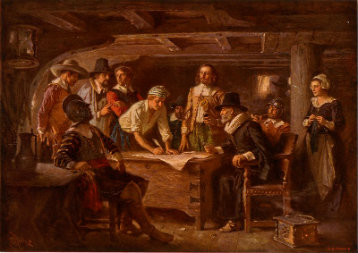How To Use This Discussion Guide
Materials Included | Begin by reading Nathaniel Hawthorne’s “The May-Pole of Merry Mount” on our site or in your copy of What So Proudly We Hail.
Materials for this guide include background information about the author and discussion questions to enhance your understanding and stimulate conversation about the story. In addition, the guide includes a series of short video discussions about the story, conducted by Yuval Levin (National Affairs) with the editors of the anthology. These seminars help capture the experience of high-level discourse as participants interact and elicit meaning from a classic American text. These videos are meant to raise additional questions and augment discussion, not replace it.
Learning Objectives | Students will be able to:
- Contrast and compare two guiding ideas of the American republic: the pursuit of happiness (see the Declaration of Independence) and the spirit of reverence (see the Mayflower Compact) as personified in Nathaniel Hawthorne’s “The May-Pole of Merry Mount;”
- Read closely to determine what the text says explicitly and to make logical inferences from it;
- Cite specific textual evidence when writing or speaking to support conclusions drawn from the text;
- Determine central ideas or themes of a text and analyze their development
- Summarize the key supporting details and ideas;
- Analyze how and why individuals, events, and ideas develop and interact over the course of a text;
- Interpret words and phrases as they are used in a text, including determining technical, connotative, and figurative meanings, and analyze how specific word choices shape meaning or tone; and
- Analyze how two or more texts address similar themes or topics to build knowledge or to compare the approaches the authors take.
Common Core State Standards Addressed | Literacy in History/Social Studies
-
RH.9-10.1, RH.9-10.2, RH.9-10.3, RH.9-10.6, RH.9-10.8, RH.11-12.1, RH.11-12.2, RH.11-12.4
English Language Arts:
-
RL.9-10.1, RL.9-10.2, RL.9-10.3, RL.9-10.4, RL.9-10.9, RL.11-12.1, RL.11-12.3, RL.11-12.4, RL.11-12.5
Writing Prompts | Based on Common Core Standards in English Language Arts and Literacy in History/Social Studies:
- Is true love necessary for rich personal happiness? For a fulfilled life? After reading “The May-Pole of Merry Mount,” write an essay that answers the question by defining true love. Support your discussion with evidence from the text. (Informational or Explanatory/Definition; Task 12)
- What does the story suggest is the proper relationship between marriage/family and community—especially in a community like ours, which is based not on ancient traditions and families but on shared ideals and principles? After reading “The May-Pole of Merry Mount,” write an essay that compares the story’s treatment of marriage/family and community with the place of marriage/family in contemporary America, and that argues for one over the other. Be sure to support your position with evidence from the text. (Argumentation/Comparison; Task 4)
- Is there a difference between jollity (or mirth) and genuine happiness (or joy)? If so, what is the difference? Is real happiness compatible with sadness, loss, and suffering? Why or why not? After reading “The May-Pole of Merry Mount,” write an essay that addresses the question and support your position with evidence from the text. Be sure to acknowledge competing views. (Argumentation/Analysis; Task 2)


 (2 votes, average: 4.00 out of 5)
(2 votes, average: 4.00 out of 5)



Post a Comment